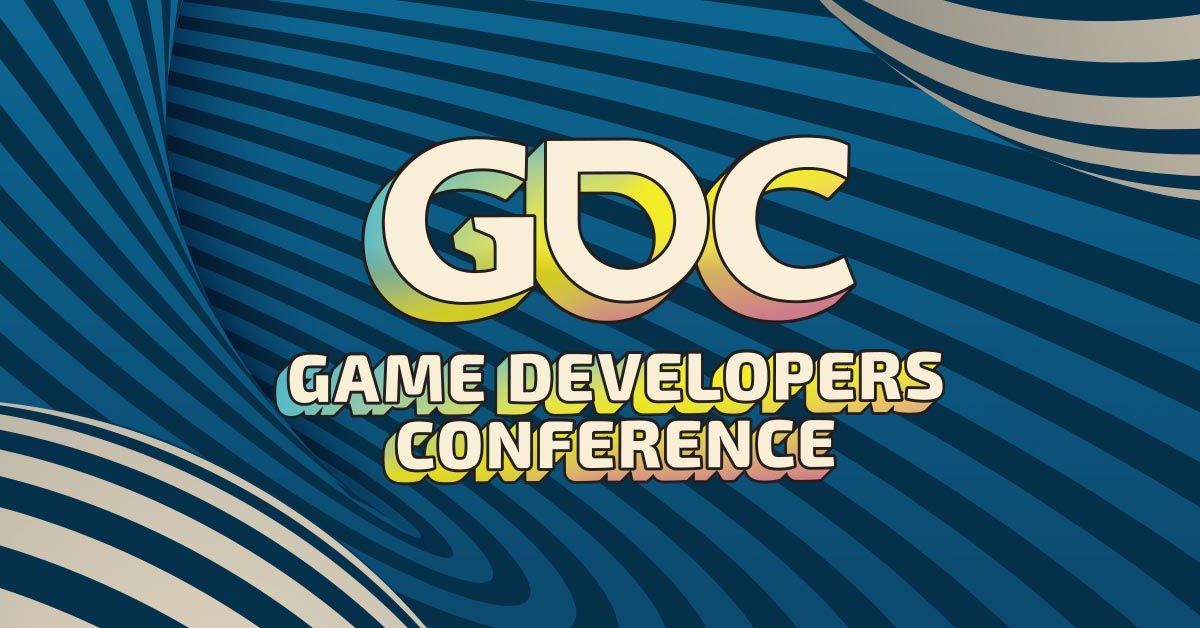Developing a Story for Your Game: A Practical Process
Developing a Story for Your Game: A Practical Process
Introduction
While there are many different ways to go about developing stories for games, in this blog post on narrative design we will focus on a process that has been passed down to multiple generations of game developers over the industry’s relatively short lifespan. This process is simple, extensible, and allows us every opportunity to stay on track and not get “lost in the weeds” during pre-production. Note that not all of these steps are needed with every project, but the process is presented here in its entirety for those who wish to apply it to their current projects or practice it on their own.
This simplified approach boils down to 5 steps:
- Developing a Concise Story Seed
- Building out the Story Treatment
- Laying out a Narrative Flowchart
- Documenting the Walkthrough
- Writing Dialog
Step #1 – Developing a Concise Story Seed
Known elsewhere as the “logline” or “pitch” (what’s the use of being in games if we can’t have our own jargon) is the step in which you will do your best impression of a salesperson or a Hollywood producer – for good reason. If your Story Seed intrigues project stakeholders there’s a good chance you’re working with an idea that can be developed into something truly memorable.
Another advantage to Story Seeds is that they are short. If you need that perfect concept for a sixty hour epic, ideas can be dreamt up and discarded quickly. If you need lots of brief stories for an ongoing episodic concern that has an insatiable need for new content, lots of ideas for stories can be quickly sanity-checked before they are allowed to move along to the next stage.
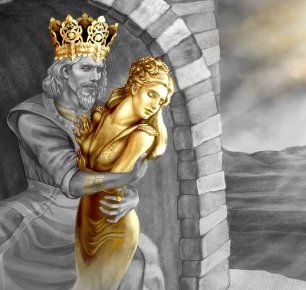
A quick note on gameplay: For simplicity’s sake let’s assume that King Midas 2: Gold Harder is a game in the style of Half-Life 2 – a shooter at its heart, but one with “real-world” or “in-game” puzzles that sometimes involve physics (example: pushing a crate up against the outer wall of a building in order to gain access to the roof). In our game, Midas will have the power to turn people and objects (including liquids) into solid gold, but also to return them to their original states. He will shoot golden orbs from his hand that, while they look exquisite, are very painful for enemies to get struck by.
It is only with the game’s mechanics in mind that we can create a story that we are confident will dovetail nicely with gameplay to the point in which gameplay can become a storytelling device all on its own.
With all this in mind, let’s take a crack at our Story Seed:

When King Midas leaves his castle to beseech Dionysus to rid him of the “Midas Touch” and give him the power to restore his daughter Zoe to her original state, Zoe’s gilded statue is stolen, and he has just forty-eight hours to find her before she is lost, this time forever.
A good Story Seed clearly defines for us three things:
- A strong protagonist , in this case King Midas.
- An emotional hook – the theft (kidnapping?) of his daughter in gold statue form
- A clear conflict – Midas has just forty-eight hours to retrieve it from those who stole it
Note that having these qualities does not necessarily guarantee that anyone will be entranced with a given Story Seed, but the absence of them will undoubtedly lead to the writer having to revise it or let it fall to the cutting room floor in favor of another idea.
If however, the project’s stakeholders feel you have a real winner on your hands, you may be ready to move on to the next step.
Step #2 – Building out the Story Treatment
In my personal experience the Story Treatment phase is the most overlooked step in the game writing process. I have personally seen many game developers leave pre-design with little more than a Story Seed, a few plot twists, a possible ending or two, and a hazy idea of what happens in between. Beginning development of a game in which the story matters with only a vague idea of how the story unfolds always courts disaster later – the type that invites wasted art assets, wasted time, and grumbling from the dev team.

The most important thing to establish in the treatment phase is a solid beginning, middle, and end(s) to your story. If that sounds obvious, consider again that many game developers start development of story-centric games without these guideposts to navigate by. Even a brief Story Treatment will need more high-level details than these however, if we’re going further things along while keeping project stakeholders on board.
To that end, you might consider building out your treatment using this practical outline offered by Brian McDonald in his excellent book on writing, Invisible Ink : A Practical Guide To Building Stories That Resonate.
- Once upon a time…
- And every day…
- Until one day…
- And because of this…
- And because of this…
- Until finally…
- And ever since that day…
Let’s give this a try with King Midas 2
:
Once upon a time there lived a king named Midas who was given the ability to turn whatever he touched into gold. After his “gift” turned his only daughter (Zoe) into a gilded statue, he lapsed into despair. Now at the end of his life, Midas is miserable, alone, and has had most of his legendary wealth stolen from underneath him, save for this statue that serves as a haunting reminder of his greatest shame and deepest regret.
And, as the decades passed, every day he cursed himself for being so shortsighted, while his few remaining subjects scouted the country for the one thing that might cure his daughter.
Until one day one of these scouts “struck gold” by spotting the god Dionysus, who had made another rare appearance on earth.
And because of this Midas set forth from his castle to confront Dionysus and strike another bargain with him, leaving the statue of his daughter unprotected.
And because of this Midas confronted Dionysus, who let him keep the power of “golden touch” but gave him the ability to transform anything he’d turned into gold back to its original form with this caveat: Both gifts would disappear forever after forty-eight hours.
And because of this Midas was forced to do Dionysus a favor in return, which kept him away from his castle longer than he expected.
And because of this the statue of his daughter was stolen.
And because of this Midas was forced to pursue a Persian Pirate Prince through hostile territory, using his gifts to defeat enemies, escape traps, and manipulate his environment (puzzles) en route to retrieving his daughter’s statue before his gifts vanished.
Etc., etc.
Until finally, King Midas lay dying, but is able to transform his daughter back to flesh just before his gifts disappear, and with just enough time to wish her goodbye, and to see that she is now safe from harm.
And ever since that day , Midas’ soul was at rest, and his Daughter lived happily ever after, the Pirate Prince (now reformed) at her side, helping her to restore her father’s kingdom to its former glory.
There is no set length for Story Treatments, though you should keep them focused on the big picture. For brief stories of an episodic nature, a few paragraphs might be enough. Even for an epic tale that supports sixty hours of gameplay, a truly “high level” treatment might not exceed a single page. However, you should also consider that for more robust stories several Story Treatments of varying length might be necessary. For example, stakeholders may want you to go from a Story Seed to a one-page treatment to make sure high-level executives are still on board with things before a writer spends the time to write a separate, two to three page treatment that will also make the rounds (albeit with probably fewer busy executives to scrutinize it).
As for style, I like to write these almost as if I’m writing prose, as I feel it keeps readers entertained. As with nearly all phases of this process, you’re continually trying to reassure those around you that this is a story with investing considerable time, money, and energy into. However, there’s nothing wrong with breaking the fourth wall here and there to illustrate your point.
Examples:
“ I imagine the ‘bargain’ Midas strikes with Dionysus to be the start of our tutorial ”
“ Here’s our classic: ‘lose-the-world-yet-gain-your-soul’ ending ”.
Step #3 – Laying out a Narrative Flowchart
With a solid treatment (or treatments) under your belt it’s time to zoom in on your vision for the game’s narrative by mapping out the story within the larger context of the game itself. Using our Narrative Flowchart we will decide exactly when , where , and how our story is told to the player. It is usually the longest and most labor-intensive part of the process, but well worth the time to get right. The steps after this become relatively simpler with a well-thought-out Narrative Flowchart in place.
A Narrative Flowchart can take several forms. For a game with a single gameplay mechanic and a strictly linear story, such as a Match-Three game, you may need only an outline which is similar to the treatment, but more specific. Let’s take a look at a match-3 game that uses our hypothetical story, King Midas 2: Gold Harder , from the first of this series of blogs:

For games that contain a variety of gameplay features and storytelling methods, as well as branching (nonlinear) narratives, traditional flowcharts are more useful.
Whenever possible I like to create Narrative Flowcharts on-site with a dev team, using a whiteboard, some different colored markers, and the collective energy of a group of creatives jazzed about the game they’re making. Yet any commonly accessible flowchart app will do for a writer working on their own, and in a pinch Excel is just fine, too.
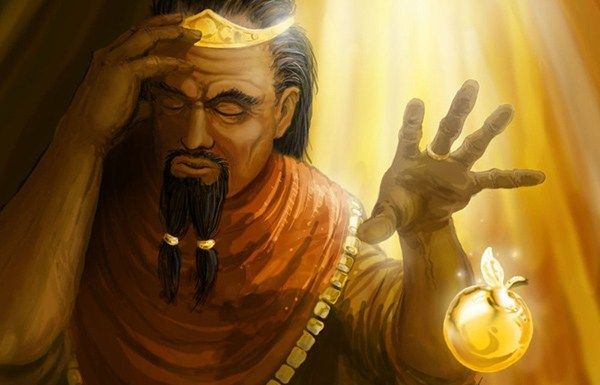
Before we start, let’s again consider all the features we have to work with in regards to the our example, King Midas 2: Gold Harder:
- Cinemas (player is passive),
- Interactive (branching) dialogs : player guides a conversation with one or more non-player characters (NPCs).
- Combat : in our case, turning people into gold statues and possibly, to flesh again afterwards.
- Environmental Puzzles : turning liquids into solid gold and back again. Turning an object that’s light (a feather) it into solid gold so its increased weight affects the environment (example: nest containing the feather falls out of a tree).
- Exploration : In our hypothetical game, exploration is a catch-all that includes finding collectables, discovering items that add to the world’s lore (scrolls, books, tapestries, paintings, chatty NPC’s, scripted events, etc.), as well as important items the Player’s needs to progress through the game, and more.
The best way to get your flowchart started is to use the major story moments in your treatment as guideposts, then work backwards, continually asking yourself the question –
“What has to happen for the Player to get here
?”
Let’s start with a dramatic moment from our Story Treatment:

And because of this the statue of his [Midas’] daughter was stolen.
I’m going to drive that stake in the ground, then work backwards towards the beginning of our game. This is a big moment, so I’m going to make it a cinema . To keep track of how many cinemas are in the game and where they occur, I’m going to color all cells in my flowchart that contain cinemas red.

But what needs to happen prior to this?
Thanks to the treatment, I know that King Midas, along with his dimwitted man-at-arms, Cadmus, make a rare foray from their castle because Dionysus – the Greek god that gave Midas the “gift” of Golden Touch – had been spotted not far away in an ancient temple. I know that Midas will confront Dionysus, and what will happen as a result of that confrontation. I also know that afterwards Midas will rush back to his castle to try and cure his daughter, Zoe, only to find Zoe’s gold statue missing.
So before discovering Zoe’s statue is stolen, Midas needs to return to his castle. Perhaps while doing so he is set upon by brigands watching the roads for an easy mark (a nice excuse to use some of the new gifts Dionysus will give Midas after their confrontation). In our flowchart, all combat sequences will be green.
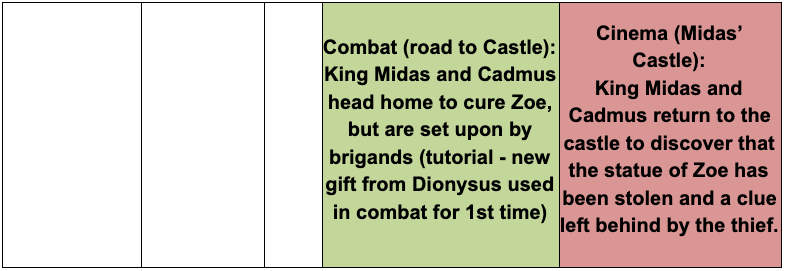
But what needs to happen prior to this?
Perhaps before Midas can leave the Ancient Temple in which Dionysus gives Midas the ability to reverse the Golden Touch, Dionysus asks Midas for a favor (Greek gods, amirite?). This could be a good opportunity to teach the Player how to use this new gift to solve environmental puzzles. I see our Dionysus as a party animal who serves as some comic relief, so perhaps his pants are stuck some place where he can’t reach them (or won’t, because he’s lazy and has a bad hangover).
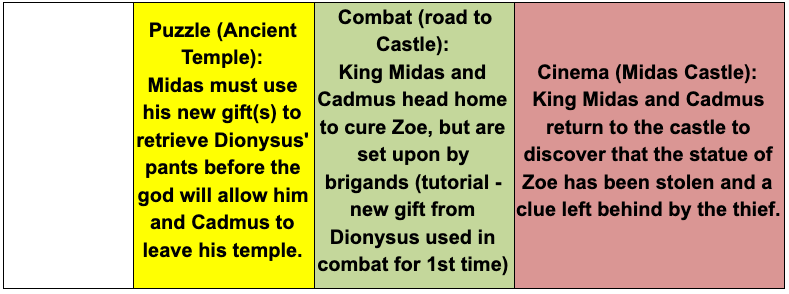
Obviously, I’m not getting into any detail regarding the puzzle (or anything else). The pants-finding I can leave to the game designer in charge of puzzles. The combat I can leave to the game designers in charge of combat, and the cinema I can describe further in the next phase, the Walkthrough.
But what needs to happen prior to this?
We’ll need Dionysus to reveal to Midas that he’s not going ANYWHERE until he finds the god’s pants. We can do that with a brief cinema.
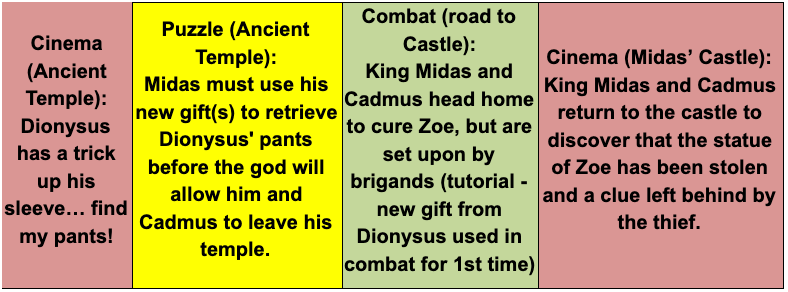
But what needs to happen prior to this?
Midas finds Dionysus in an ancient temple built to honor the god. Perhaps BEFORE Dionysus ropes King Midas into retrieving his pants, but AFTER the god gives Midas the cure for the Midas Touch, Dionysus allows King Midas to explore the ancient temple, knowing full well that the only way in or out is now sealed (again – devious buggers, these gods). This will allow the Player the opportunity to find a collectible we’ve hidden for them, and interact with items in the environment that will fill them in on some backstory (a mural depicting the first meeting of Midas and Dionysus would be a nice touch). They could also briefly interact with Cadmus or Dionysus’ Hairdresser (another NPC), if they so wish.

In my flowchart, Interactive Dialog sequences will be blue and notable exploration opportunities will be orange. Note that these three new gameplay sequences are stacked vertically – they can be done in any order (or skipped entirely, which will be made clear in the upcoming Walkthrough).
And so on and so forth.
Using this process, I can keep working backwards until I get to the very beginning of the game. With all of this added to the flowchart, I can then look ahead to other key moments in the game’s story and work backwards from those until I reach this sequence. In this way the entire game can be plotted out (bonus points to the narrative designers who have the least amount of red cells (costly Cinemas) in their flowchart.
Branching Narrative
Allow me to skip ahead and give an example of how we’d handle branching narrative. At this particular moment in our story, King Midas needs to reach a harbor on the coast and find a boat, quickly , so he can stay in hot pursuit of the pirate prince who stole the gold statue of his daughter, Zoe. We’ll give the Player two paths they can use to reach the harbor — one features more environmental puzzles than combat. The other offers the opposite experience. Players who prefer one or the other will be able to choose the gameplay experience that suits them best.
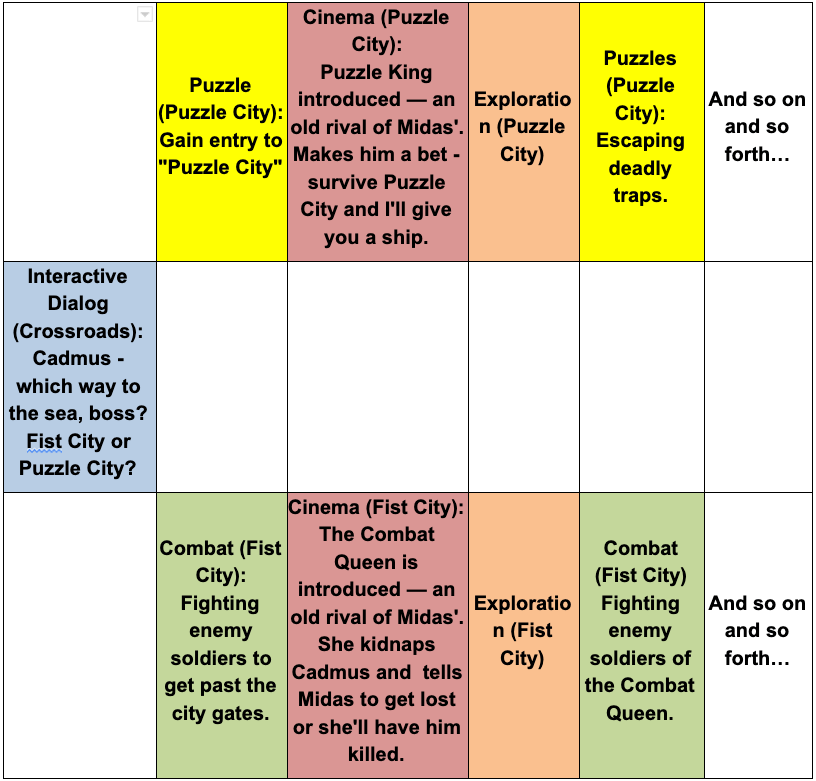
The Interactive Dialog at far left ( blue ) is placed between two alternate paths. Once the player chooses a path, they’re stuck with their choice (at least with that particular saved game) until they emerge from either Fist City or Puzzle City, after which Midas will reach the harbor and the alternate paths will converge so we’re back to one main story path for a while.
Narrative flowcharts (also known as “dependency charts”) aren’t sexy, but if you put in the time to get them right you’ll be in great shape throughout development, and so will be the rest of the team as they work to create the assets and functionality needed to tell the story.
There is more to Narrative Flowcharts, but this should be enough to get you on your way. Remember, this is the meat and potatoes of narrative design.
Step #4 – Documenting The Walkthrough
Congratulations!

If you’ve made it this far, the rest is downhill. The Walkthrough is simply your Narrative Flowchart with important details added so as to fully illustrate the entire experience from the Player’s perspective.
The final result won’t look too different from a well-written walkthrough a fan might create after thoroughly playing your game from beginning to end. You can use your Walkthrough to illustrate:
- The emotions behind each character interaction.
- Any changes (or potential changes) to the state of the Player’s inventory (assuming they have one) from sequence to sequence.
- Links to reference images that will help game designers, artists, and others to understand the settings, characters, and other things described.
- Anything else you feel the need to express in order to get your vision across.
While Story Seeds and Story Treatments , having served their purpose, are usually left by the wayside, the Walkthrough is a living document, and while keeping the same information in two places at once can be tricky, it’s a good idea to update your Narrative Flowchart with any changes as well, as it still serves to give you a good bird’s eye view of the game at a glance.
In the following example, we’ll take this segment of our Narrative Flowchart and translate it into Walkthrough form. NOTE: This part of our game’s story occurs immediately after King Midas receives the the “gift” (or cure) for his “Golden Touch” from Dionysus, henceforth known as the “reverse Golden Touch” – the power to turn things back from gold to their natural state
.
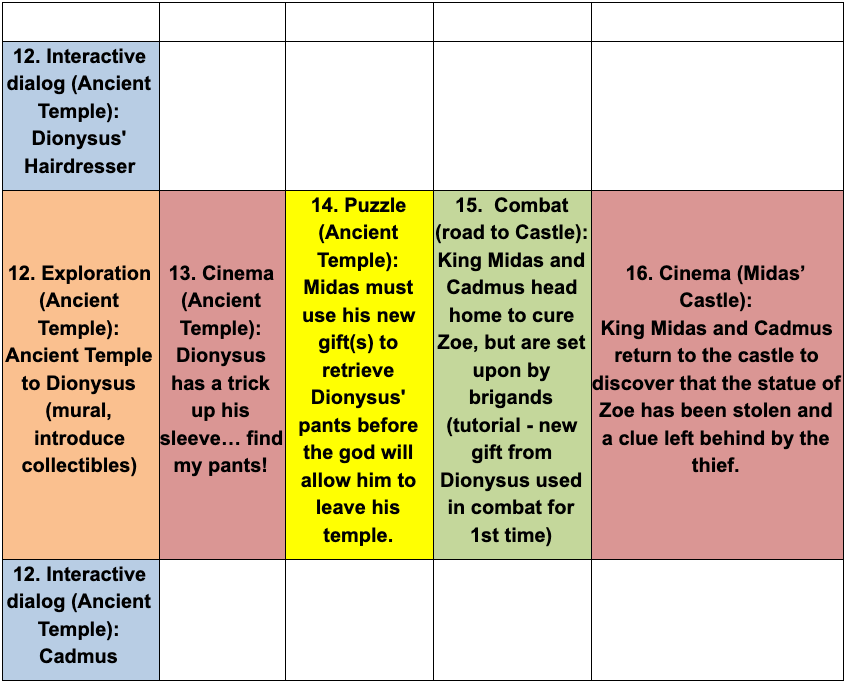
Let’s start with the three sequences at far left: two interactive dialogs
and some exploration
:
12. INTERACTIVE DIALOG: DIONYSUS’ HAIRDRESSER
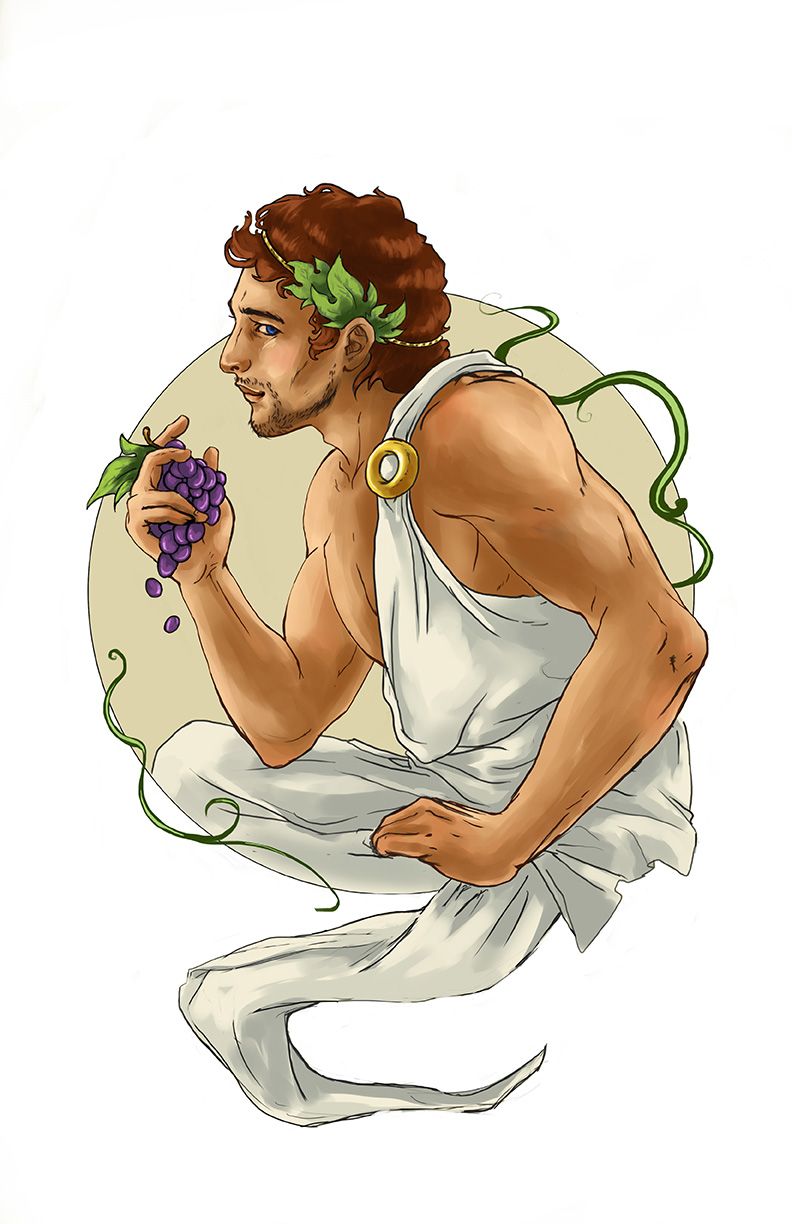
Setting: ANCIENT TEMPLE
Condition: Sequence 11 (cinema: Dionysus and his hairdresser reconcile)
A brief interaction with Dionysus’ hairdresser sheds some light on their tumultuous relationship and Dionysus’ unpredictable nature, giving us a hint at what a help and a hindrance he will be to Midas in the future.
Inventory : dagger, Flip-Flops of Swiftness
12. INTERACTIVE DIALOG: CADMUS’ THOUGHTS
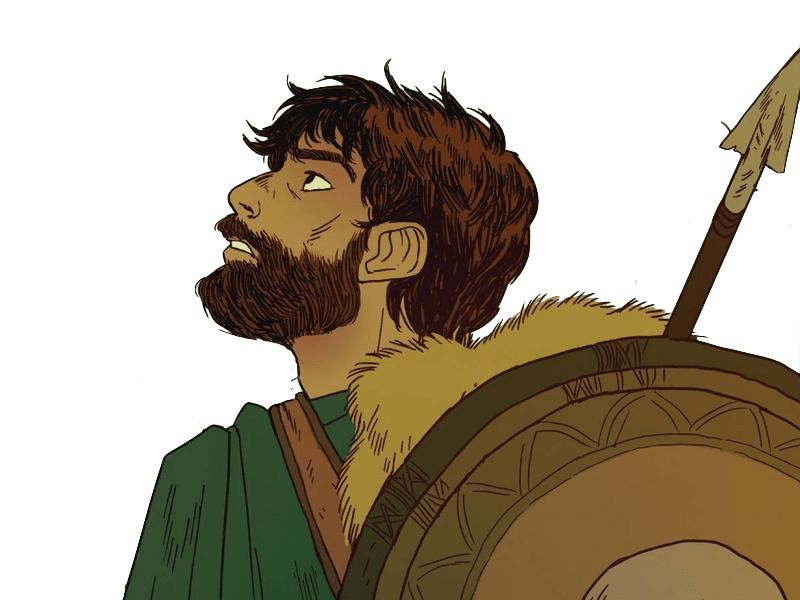
Setting: ANCIENT TEMPLE
Condition: Sequence 11 (cinema: Dionysus and his hairdresser reconcile)
A brief interaction with Cadmus will reveal how excited he is to have found the means with which to return Zoe to human form. He’ll also encourage Midas to explore the temple a bit in case there’s anything that might come in useful to them on the journey home — as well as warn his king of the dangers of the road that takes them back to their castle. He is also wary of Dionysus, but likes his hair.
He is also nervous about leaving their castle unprotected as it’s constantly being broken into, even though almost all the gold has already been stolen.
Inventory : dagger, Flip-Flops of Swiftness
12. EXPLORATION: ANCIENT TEMPLE
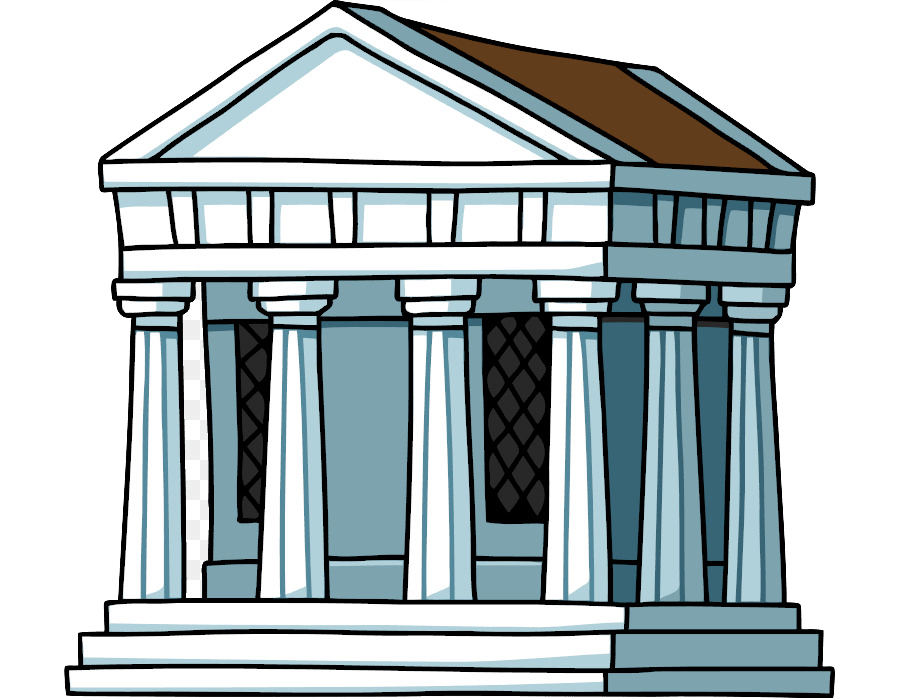
Setting: ANCIENT TEMPLE
Condition: Sequence 11 (cinema: Dionysus and his hairdresser reconcile)
- Exploration of the ancient temple to Dionysus will reveal a faded mural or frieze – a sequence of panels that depict the first meeting between Midas and Dionysus in which the overweight party god is falsely shown to have washboard abs and flawless cheekbones.
- Collectible bust 1 of 100 is found somewhere in the Ancient Temple: Bust of Apollo.
- There is one flask of healing wine somewhere here.
- There is a sack of gold coins somewhere here.
Added to Inventory : sack of gold coins, flask of healing wine
Inventory : dagger, Flip-Flops of Swiftness
Why are all three of these sequences given the number twelve?
First, we know there are several sequences that have to happen prior to these three — the opening cinema for example. Let’s say that as with most games, the opening cinema is the very first thing to happen in King Midas 2. In our Walkthrough we’d assign the opening cinema the number one, and for the sake of example let us arbitrarily say that there are ten other sequences that take place after that before we get to these three at sequence number twelve.
We assign the number twelve to all three of these sequences for the same reason they are stacked vertically in our Narrative Flowchart. Within our game’s timeline they become accessible to the player simultaneously, but can be done in any order (or in fact, can be skipped entirely).
Once the player tries to exit the Ancient Temple however, our next sequence becomes unlocked. Let’s go ahead and translate the rest of the Narrative Flowchart into Walkthrough form. NOTE: All dialog is considered placeholder – just enough to get across the intention.
13. CINEMA: DIONYSUS NEEDS A FAVOR

Setting: ANCIENT TEMPLE
Condition: Player tries to exit the temple.
Dionysus has sealed the only exit to the temple. “You didn’t think I’d give you the cure for the Golden Touch for nothing, did you? Here comes the rub, chump!”
Midas is furious. He wants to get back to his castle and cure his daughter, and he’s nervous about leaving her statue unprotected. Thankfully, despite the build up here, Dionysus doesn’t want much — just his pants, which ended up getting lost during last night’s bender.
Inventory : dagger, Flip-Flops of Swiftness, sack of gold coins, flask of healing wine
14. PUZZLE: RETRIEVE DIONYSUS’ PANTS

Setting: ANCIENT TEMPLE
Condition: Sequence 13 (cinema: Dionysus Needs a Favor)
Midas must use his new gift to retrieve Dionysus’ pants before the god will allow him to leave his temple. Tutorial : This is the first time the “reverse Golden Touch” will be used during a puzzle sequence.
Inventory : dagger, Flip-Flops of Swiftness, sack of gold coins, flask of healing wine
15. COMBAT: BRIGANDS WANT MIDAS’ HANDS
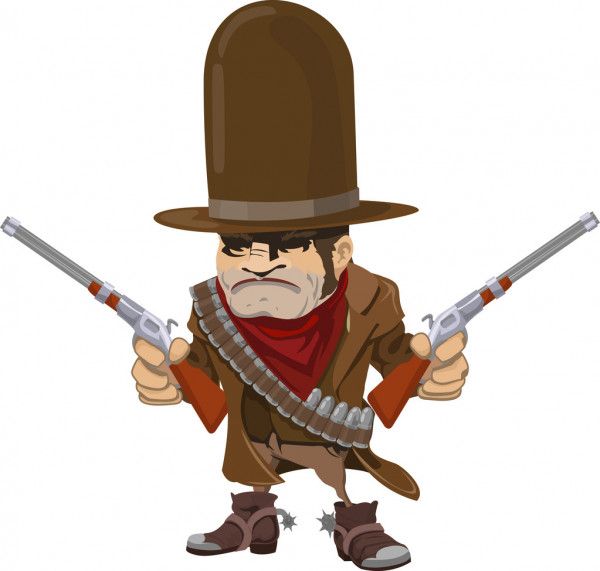
Setting: ROAD BACK TO MIDAS CASTLE
Condition: Sequence 14 (puzzle: retrieve Dionysus’ pants solved, temple exited, Midas heads towards his castle)
King Midas and Cadmus rush towards the castle to cure Midas’ daughter, Zoe, but are set upon by brigands who are pumped to see Midas has left his castle. Somehow they have the idea that if they cut off Midas’ hands, they can use them to turn things into gold. Tutorial : Dionysus’ “reverse Midas Touch” used in combat for the first time.
Removed from Inventory : sack of gold coins, flask of healing wine
Inventory : dagger, Flip-Flops of Swiftness
16. CINEMA: STATUE OF MIDAS’ DAUGHTER IS STOLEN
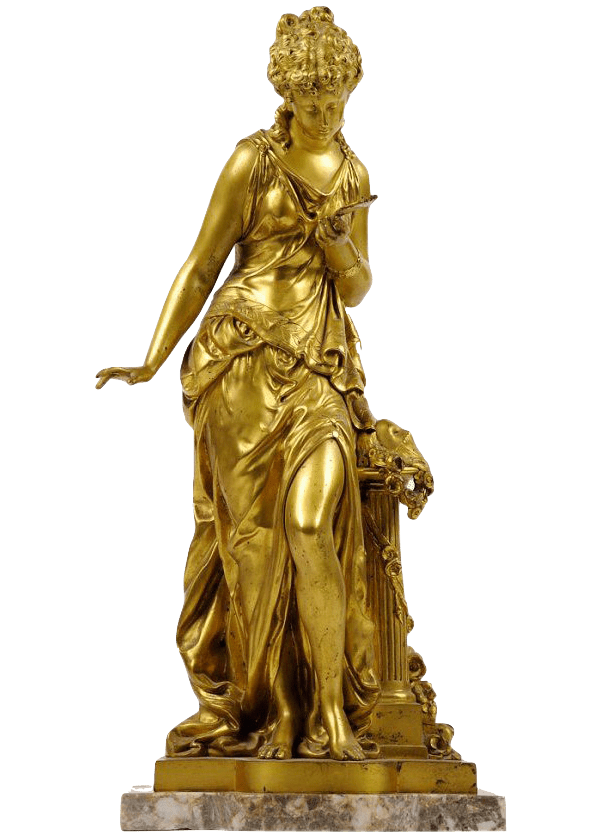
Setting: MIDAS’ CASTLE (THRONE ROOM)
Condition: Sequence 15 (combat: brigands want Midas’ hands)
Midas returns to his throne room to discover that while he and Cadmus were gone, someone broke into his castle and stole the gold statue of his daughter, Zoe. Midas is crushed — he’s waited decades to find the means to cure her, allowing his entire kingdom to go to hell around him, and now she’s gone. Thankfully, the thief couldn’t resist leaving behind a calling card. From this clue, Midas deduces that the thief is a Persian pirate of some reputation. Therefore, he must be headed back to the sea with his stolen loot, and thankfully there’s only one route to the closest harbor.
Added to Inventory: Pirate Thief’s Signature
Inventory : dagger, Flip-Flops of Swiftness, Pirate Thief’s Signature
It’s fairly obvious to see that each sequence that’s stacked horizontally in the Narrative Flowchart is assigned a unique number in our Walkthrough (see 13 -16). This reinforces the notion that before a given sequence is accessible to the player, the sequence before it must have occurred (or have been made available). Further details as to these conditions can be described under the “Condition” header. You will also note that any potential changes to the Player’s inventory (whether they actually occur or not) are easy to track through the Walkthrough.
Most important however, is that you take the opportunity to discuss the motivations, emotions, mood, and context for each cinema, NPC interaction, and gameplay sequence in relation to your story.
Step #5 – Writing Dialog
After giving the artists, game designers, audio designers, gameplay programmers, and others a clear roadmap they can use to add their contributions to the story, it’s time to flee to the quietest place you can find and hide so you can write crisp, pointed, and at times hilarious dialog brimming with subtext that will change the lives of the Players who are lucky enough to experience your cinemas — unless they skip them.
There are literally hundreds of good resources out there on the art of writing dialog and precious little that I can add to that conversation that hasn’t been heard before. Instead, let’s consider the restraints us game writers must keep in mind before we start writing dialog.
Before you get started, be sure to work out with your programmers, producers, audio designers, localization folks, and any other relevant parties the details surrounding your localization pipeline, voice over pipeline (if applicable) and how exactly dialog will be displayed in your game (again, if applicable). For example, if your dialog is to be seen on-screen will you use word balloons? Boxes at the bottom of the screen? Will these things point at the person speaking? If not, how will you handle attribution? Will you need different types of balloons or boxes to represent different types of dialog (speech, thought, sound effects, voices coming from radios or TVs, etc.)? How will you EMPHASIZE words: all caps, italics, bold? What about dual dialog (more than one character speaking at the same time)? The more you’ve thought out the design and mechanics behind how your dialog is presented to the player, the more effective you’ll be at writing dialog that does your characters justice.
Here some resources that may help:
- Blambot: Comic Book Grammar & Tradition
- Foreign Dialects: A Manual for Actors, Directors, and Writers
- American Dialects: A Manual for Actors, Directors, and Writers
- Newsweek: David Mamet’s 6 favorite books with amazing dialogue
- Robert McKee’s Dialogue: The Art of Verbal Action for Page, Stage, and Screen
A final thought – Is it uh… “Good”?
Unfortunately, even with other stakeholders scrutinizing a writer’s output at each phase of this process, we can’t necessarily vouch for the creativity of the story being developed (we’ll cover QA for writers in some future blog posts). It is entirely possible that a story created using this process, while it checks all the boxes, can ultimately fail to please. However, by being careful to use these steps you can be certain that you will not need to halt during mid-production to solve nasty story problems in mid-development while artists sit on their hands and wait impatiently. In other words, you will not get “lost in the weeds” — which is all well and good for novelists, but not when you’ve got a development team, a limited budget, and looming milestones to worry about.
Thank you to Erin McGechaen at East Side Games for her excellent insight into story pitches. Thanks to author Brian McDonald for sharing his wisdom in his excellent book, Invisible Ink: A Practical Guide To Building Stories That Resonate , and special thanks to David Grossman and Noah Falstein for their wisdom and insight while sharing this process with me early in my career.
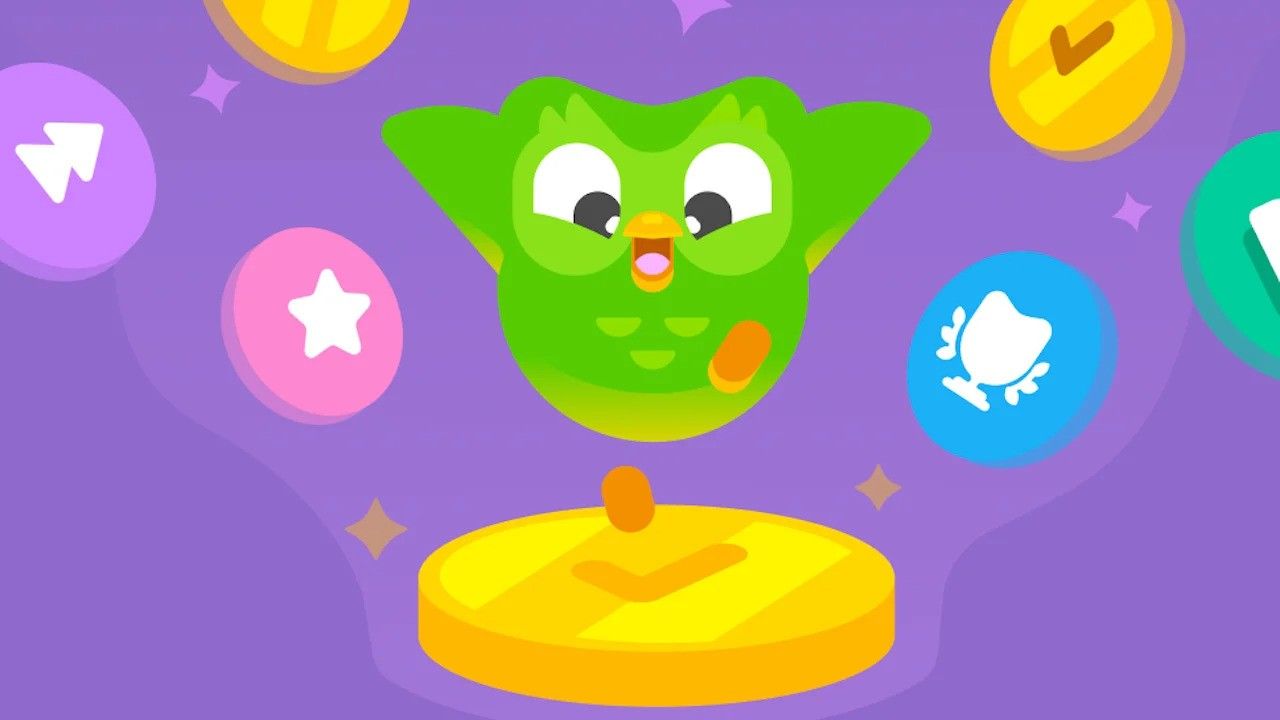
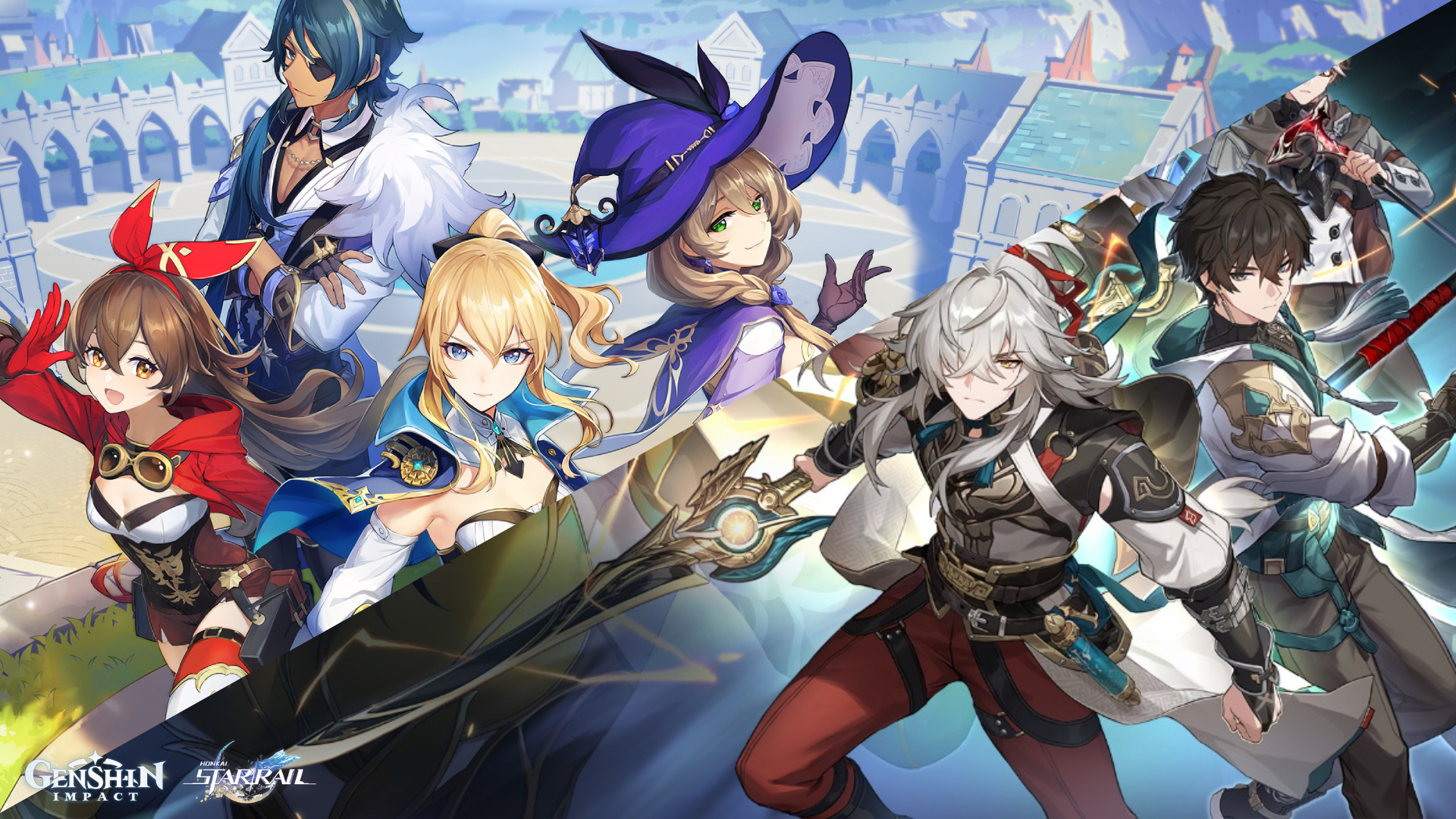




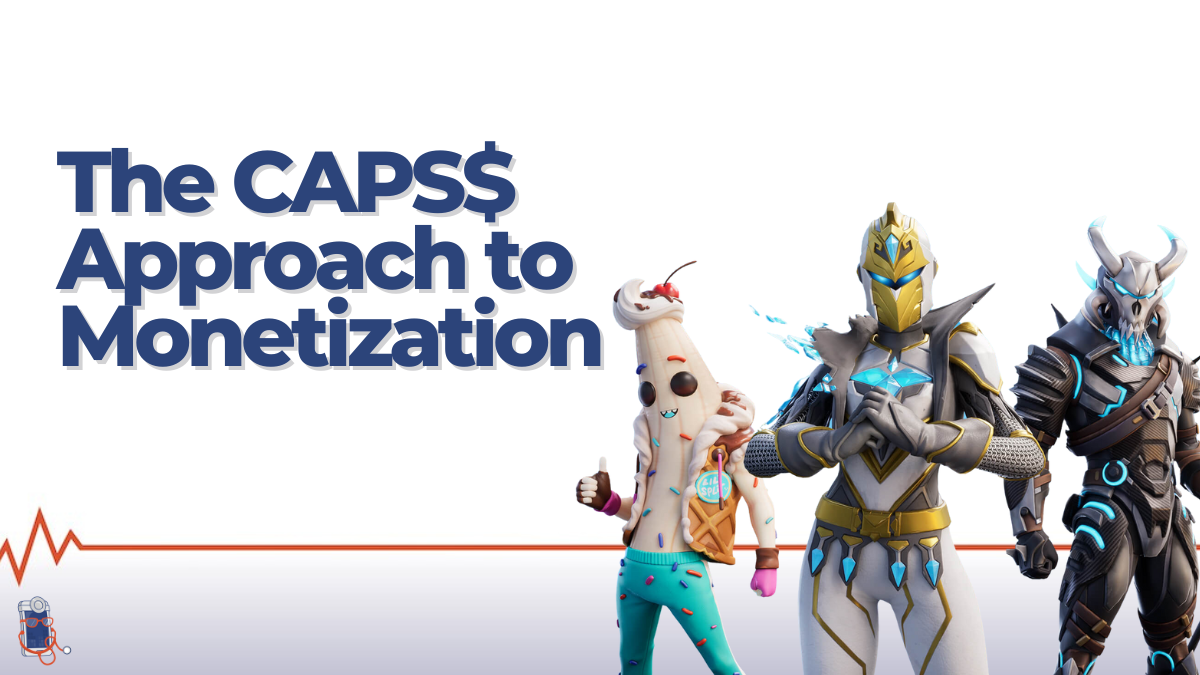
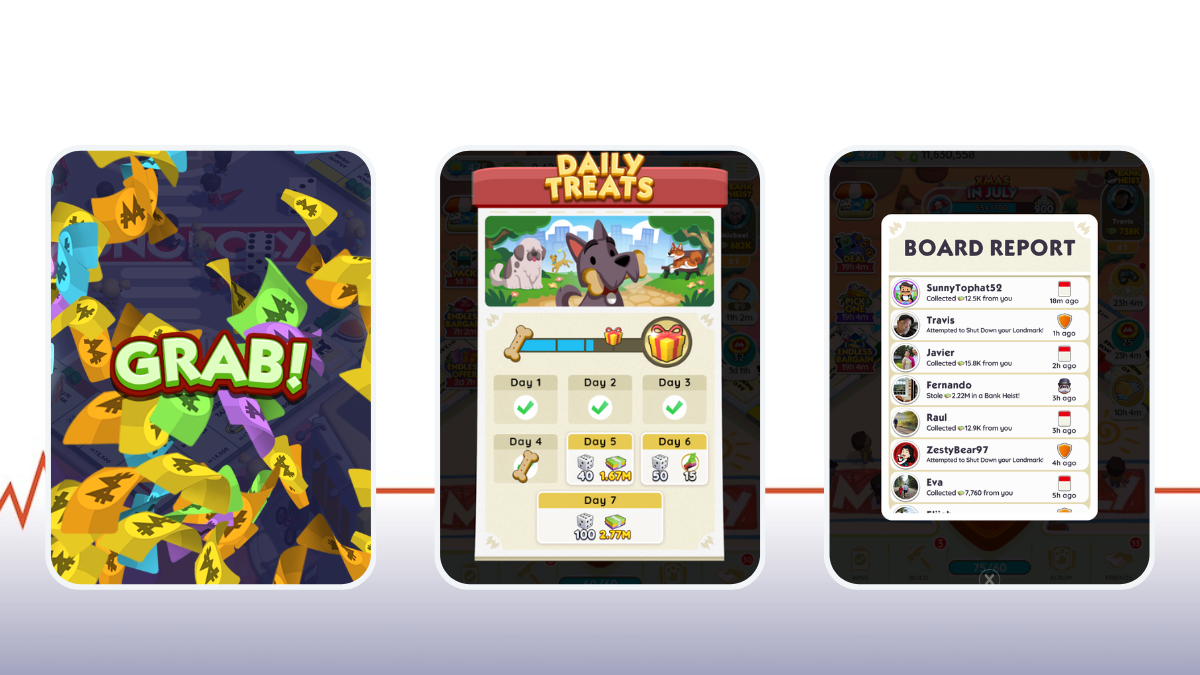
Quick Links
Services
Join Our Newsletter
We will get back to you as soon as possible.
Please try again later.
All Rights Reserved | Mobile Game Doctor | Accessibility | Privacy Policy | Terms & Conditions


